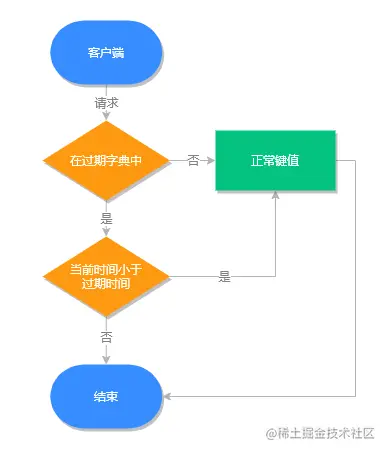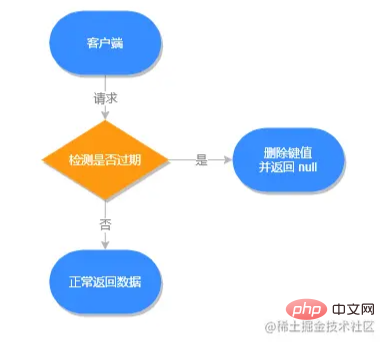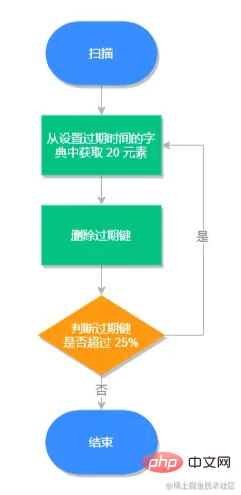 Database
Database
 Redis
Redis
 An article to talk about expiration operations and expiration strategies in Redis
An article to talk about expiration operations and expiration strategies in Redis
An article to talk about expiration operations and expiration strategies in Redis
This article will take you to understand the expiration operation and expiration strategy in Redis, introduce the four methods of setting expiration time in Redis, expired keys in persistence, expired key execution process, etc. I hope it will be helpful to everyone. !

If there is no concept of expiration in Redis, this means that all the keys we write will always be saved in # as long as they are not actively deleted. ##Redis, and Redis is a memory-based database, and the memory space is very limited. [Related recommendations: Redis video tutorial]
Expiration setting
## There are four main ways to set expiration time in #Redis:
- expire key seconds
- : Set
keyto expire after n seconds. pexpire key milliseconds - : Set
keyto expire in n milliseconds. expireat key timestamp - : Set
keyto expire after a certain timestamp (accurate to seconds). pexpireat key millisecondsTimestamp - : Set
keyto expire after a certain timestamp (accurate to milliseconds). You can use the command
(in seconds) or pttl key (in milliseconds) to view the key How long does it take to expire.
You can use the time command to query the timestamp of the current time (accurate to seconds). Several methods for directly operating expiration time in strings, as listed below:
- set key value ex seconds
- : Set the key value pair and specify expiration at the same time Time (accurate to seconds).
- : Set the key value pair and specify the expiration time (accurate to milliseconds).
- : Set the key-value pair and specify the expiration time (accurate to seconds).
Remove the expiration timeUse the command:
persist key You can remove the expiration time of the key value . -1 means never expires.
Java implements expiration operationsUse
Jedis to implement operations on Redis, code : <div class="code" style="position:relative; padding:0px; margin:0px;"><pre class='brush:php;toolbar:false;'>public class TTLTest {
public static void main(String[] args) throws InterruptedException {
// 创建 Redis 连接
Jedis jedis = new Jedis("xxx.xxx.xxx.xxx", 6379);
// 设置 Redis 密码(如果没有密码,此行可省略)
jedis.auth("xxx");
// 存储键值对(默认情况下永不过期)
jedis.set("k", "v");
// 查询 TTL(过期时间)
Long ttl = jedis.ttl("k");
// 打印过期日志
// 过期时间:-1
System.out.println("过期时间:" + ttl);
// 设置 100s 后过期
jedis.expire("k", 100);
// 等待 1s 后执行
Thread.sleep(1000);
// 打印过期日志
// 执行 expire 后的 TTL=99
System.out.println("执行 expire 后的 TTL=" + jedis.ttl("k"));
}
}</pre><div class="contentsignin">Copy after login</div></div>
, as listed below:
- pexpire(String key, long milliseconds)
- : Set n milliseconds expires later.
- : Expires after setting a certain timestamp (accurate to seconds).
- : Expires after setting a certain timestamp (accurate to milliseconds).
- : Remove expiration time.
public class TTLTest { public static void main(String[] args) throws InterruptedException { // 创建 Redis 连接 Jedis jedis = new Jedis("xxx.xxx.xxx.xxx", 6379); // 设置 Redis 密码(如果没有密码,此行可省略) jedis.auth("xxx"); // 存储键值对(默认情况下永不过期) jedis.set("k", "v"); // 查询 TTL(过期时间) Long ttl = jedis.ttl("k"); // 打印过期日志 System.out.println("过期时间:" + ttl); // 设置 100s 后过期 jedis.expire("k", 100); // 等待 1s 后执行 Thread.sleep(1000); // 打印过期日志 System.out.println("执行 expire 后的 TTL=" + jedis.ttl("k")); // 设置 n 毫秒后过期 jedis.pexpire("k", 100000); // 设置某个时间戳后过期(精确到秒) jedis.expireAt("k", 1573468990); // 设置某个时间戳后过期(精确到毫秒) jedis.pexpireAt("k", 1573468990000L); // 移除过期时间 jedis.persist("k"); } }Copy after login
Expired keys in persistence
Expired keys in RDBRDB
The file is divided into two stages, RDB The file generation stage and the loading stage.
RDB
Loading is divided into the following two situations:
- is the
- main
server operating mode, when loading theRDB file, the program will check the keys saved in the file, and expired keys will not be loaded into in the database. Therefore, expired keys will not affect the main server that loads the RDBfile;IfRedis is running in - slave
server mode, in When loading aRDB file, the key will be loaded into the database regardless of whether it has expired. But when the master and slave servers perform data synchronization, the data of the slave server will be cleared. So generally speaking, expired keys will not affect the slave server loading theRDB file. RDB
rdbLoad() function of the rdb.c file. The source code is as shown:
/* Check if the key already expired. This function is used when loading
* an RDB file from disk, either at startup, or when an RDB was
* received from the master. In the latter case, the master is
* responsible for key expiry. If we would expire keys here, the
* snapshot taken by the master may not be reflected on the slave.
*
* 如果服务器为主节点的话,
* 那么在键已经过期的时候,不再将它们关联到数据库中去
*/
if (server.masterhost == NULL && expiretime != -1 && expiretime < now) {
decrRefCount(key);
decrRefCount(val);
// 跳过
continue;
}1. AOF file writing
When Redis
starts withAOF When the mode is persisted, if an expired key in the database has not been deleted, then the AOF file will retain the expired key. When the expired key is deleted, Redis A DEL command will be appended to the AOF file to explicitly delete the key value. 2. AOF rewriting
When performing AOF
rewriting, the key-value pairs inRedis will be Checking Expired keys will not be saved to the rewritten AOF file and therefore will not have any impact on the AOF rewrite.
当 从库的过期键处理依靠主服务器控制,主库在 在 过期键执行流程 过期键源码分析 过期键存储在 过期键数据结构如下图所示: 过期策略 在设置键值过期时间时,创建一个定时事件,当过期时间到达时,由事件处理器自动执行键的删除操作。 不主动删除过期键,每次从数据库获取键值时判断是否过期,如果过期则删除键值,并返回 null。 源码解析 惰性删除的源码位于 所有对数据库的读写命令在执行之前,都会调用 每隔一段时间检查一次数据库,随机删除一些过期键。 注意: 定期删除流程 从过期字典中随机取出 20 个键。 删除这 20 个键中过期的键。 如果过期 同时为了保证过期扫描不会出现循环过度,导致线程卡死现象,算法还增加了扫描时间的上限,默认不会超过 25ms。 源码解析 定期删除的核心源码在 这个函数有两种执行模式,一个是快速模式一个是慢速模式,体现是代码中的 更多编程相关知识,请访问:编程入门!!Redis 运行在主从模式下时,从库不会进行过期扫描,从库对过期的处理是被动的。也就是即使从库中的 key 过期了,如果有客户端访问从库时,依然可以得到 key 对应的值,像未过期的键值对一样返回。key 到期时,会在 AOF 文件里增加一条 del 指令,同步到所有的从库,从库通过执行这条 del 指令来删除过期的 key。过期策略
Redis 中我们可以给一些元素设置过期时间,那当它过期之后 Redis 是如何处理这些过期键呢?Redis 之所以能知道那些键值过期,是因为在 Redis 中维护了一个字典,存储了所有设置了过期时间的键值,我们称之为过期字典。
redisDb 结构中,源代码在 src/server.h 文件中(基于 Redis 5):/* Redis database representation. There are multiple databases identified
* by integers from 0 (the default database) up to the max configured
* database. The database number is the 'id' field in the structure. */
typedef struct redisDb {
dict *dict; /* 数据库键空间,存放着所有的键值对 */
dict *expires; /* 键的过期时间 */
dict *blocking_keys; /* Keys with clients waiting for data (BLPOP)*/
dict *ready_keys; /* Blocked keys that received a PUSH */
dict *watched_keys; /* WATCHED keys for MULTI/EXEC CAS */
int id; /* Database ID */
long long avg_ttl; /* Average TTL, just for stats */
list *defrag_later; /* List of key names to attempt to defrag one by one, gradually. */
} redisDb;
Redis 会删除已过期的键值,以此来减少 Redis 的空间占用,但因为 Redis 本身是单线的,如果因为删除操作而影响主业务的执行就得不偿失了,为此 Redis 需要制定多个(过期)删除策略来保证正常执行的性能。定时删除
Redis 高负载的情况下或有大量过期键需要同时处理时,会造成 Redis 服务器卡顿,影响主业务执行。惰性删除
src/db.c 文件的 expireIfNeeded 方法中,源码如下:int expireIfNeeded(redisDb *db, robj *key) {
// 判断键是否过期
if (!keyIsExpired(db,key)) return 0;
if (server.masterhost != NULL) return 1;
/* 删除过期键 */
// 增加过期键个数
server.stat_expiredkeys++;
// 传播键过期的消息
propagateExpire(db,key,server.lazyfree_lazy_expire);
notifyKeyspaceEvent(NOTIFY_EXPIRED,
"expired",key,db->id);
// server.lazyfree_lazy_expire 为 1 表示异步删除(懒空间释放),反之同步删除
return server.lazyfree_lazy_expire ? dbAsyncDelete(db,key) :
dbSyncDelete(db,key);
}
// 判断键是否过期
int keyIsExpired(redisDb *db, robj *key) {
mstime_t when = getExpire(db,key);
if (when < 0) return 0; /* No expire for this key */
/* Don't expire anything while loading. It will be done later. */
if (server.loading) return 0;
mstime_t now = server.lua_caller ? server.lua_time_start : mstime();
return now > when;
}
// 获取键的过期时间
long long getExpire(redisDb *db, robj *key) {
dictEntry *de;
/* No expire? return ASAP */
if (dictSize(db->expires) == 0 ||
(de = dictFind(db->expires,key->ptr)) == NULL) return -1;
/* The entry was found in the expire dict, this means it should also
* be present in the main dict (safety check). */
serverAssertWithInfo(NULL,key,dictFind(db->dict,key->ptr) != NULL);
return dictGetSignedIntegerVal(de);
}expireIfNeeded 方法判断键值是否过期,过期则会从数据库中删除,反之则不做任何处理。
定期删除
Redis 默认每秒进行 10 次过期扫描,此配置可通过 Redis 的配置文件 redis.conf 进行配置,配置键为 hz 它的默认值是 hz 10。Redis 每次扫描并不是遍历过期字典中的所有键,而是采用随机抽取判断并删除过期键的形式执行的。key 的比例超过 25%,重复步骤 1。
Redis 主业务的影响,同时也能删除一部分过期的数据减少了过期键对空间的无效占用。src/expire.c 文件下的 activeExpireCycle 方法中,源码如下:void activeExpireCycle(int type) {
static unsigned int current_db = 0; /* 上次定期删除遍历到的数据库ID */
static int timelimit_exit = 0; /* Time limit hit in previous call? */
static long long last_fast_cycle = 0; /* 上一次执行快速定期删除的时间点 */
int j, iteration = 0;
int dbs_per_call = CRON_DBS_PER_CALL; // 每次定期删除,遍历的数据库的数量
long long start = ustime(), timelimit, elapsed;
if (clientsArePaused()) return;
if (type == ACTIVE_EXPIRE_CYCLE_FAST) {
if (!timelimit_exit) return;
// ACTIVE_EXPIRE_CYCLE_FAST_DURATION 是快速定期删除的执行时长
if (start < last_fast_cycle + ACTIVE_EXPIRE_CYCLE_FAST_DURATION*2) return;
last_fast_cycle = start;
}
if (dbs_per_call > server.dbnum || timelimit_exit)
dbs_per_call = server.dbnum;
// 慢速定期删除的执行时长
timelimit = 1000000*ACTIVE_EXPIRE_CYCLE_SLOW_TIME_PERC/server.hz/100;
timelimit_exit = 0;
if (timelimit <= 0) timelimit = 1;
if (type == ACTIVE_EXPIRE_CYCLE_FAST)
timelimit = ACTIVE_EXPIRE_CYCLE_FAST_DURATION; /* 删除操作的执行时长 */
long total_sampled = 0;
long total_expired = 0;
for (j = 0; j < dbs_per_call && timelimit_exit == 0; j++) {
int expired;
redisDb *db = server.db+(current_db % server.dbnum);
current_db++;
do {
// .......
expired = 0;
ttl_sum = 0;
ttl_samples = 0;
// 每个数据库中检查的键的数量
if (num > ACTIVE_EXPIRE_CYCLE_LOOKUPS_PER_LOOP)
num = ACTIVE_EXPIRE_CYCLE_LOOKUPS_PER_LOOP;
// 从数据库中随机选取 num 个键进行检查
while (num--) {
dictEntry *de;
long long ttl;
if ((de = dictGetRandomKey(db->expires)) == NULL) break;
ttl = dictGetSignedInteger
// 过期检查,并对过期键进行删除
if (activeExpireCycleTryExpire(db,de,now)) expired++;
if (ttl > 0) {
/* We want the average TTL of keys yet not expired. */
ttl_sum += ttl;
ttl_samples++;
}
total_sampled++;
}
total_expired += expired;
if (ttl_samples) {
long long avg_ttl = ttl_sum/ttl_samples;
if (db->avg_ttl == 0) db->avg_ttl = avg_ttl;
db->avg_ttl = (db->avg_ttl/50)*49 + (avg_ttl/50);
}
if ((iteration & 0xf) == 0) { /* check once every 16 iterations. */
elapsed = ustime()-start;
if (elapsed > timelimit) {
timelimit_exit = 1;
server.stat_expired_time_cap_reached_count++;
break;
}
}
/* 每次检查只删除 ACTIVE_EXPIRE_CYCLE_LOOKUPS_PER_LOOP/4 个过期键 */
} while (expired > ACTIVE_EXPIRE_CYCLE_LOOKUPS_PER_LOOP/4);
}
// .......
}activeExpireCycle 方法在规定的时间,分多次遍历各个数据库,从过期字典中随机检查一部分过期键的过期时间,删除其中的过期键。timelimit 变量,这个变量是用来约束此函数的运行时间的。快速模式下 timelimit 的值是固定的,等于预定义常量 ACTIVE_EXPIRE_CYCLE_FAST_DURATION,慢速模式下,这个变量的值是通过 1000000 * ACTIVE_EXPIRE_CYCLE_SLOW_TIME_PERC/server.hz/100 计算的。Redis 使用的过期策略
Redis 使用的是惰性删除加定期删除的过期策略。
The above is the detailed content of An article to talk about expiration operations and expiration strategies in Redis. For more information, please follow other related articles on the PHP Chinese website!

Hot AI Tools

Undresser.AI Undress
AI-powered app for creating realistic nude photos

AI Clothes Remover
Online AI tool for removing clothes from photos.

Undress AI Tool
Undress images for free

Clothoff.io
AI clothes remover

Video Face Swap
Swap faces in any video effortlessly with our completely free AI face swap tool!

Hot Article

Hot Tools

Notepad++7.3.1
Easy-to-use and free code editor

SublimeText3 Chinese version
Chinese version, very easy to use

Zend Studio 13.0.1
Powerful PHP integrated development environment

Dreamweaver CS6
Visual web development tools

SublimeText3 Mac version
God-level code editing software (SublimeText3)

Hot Topics
 1386
1386
 52
52
 How to build the redis cluster mode
Apr 10, 2025 pm 10:15 PM
How to build the redis cluster mode
Apr 10, 2025 pm 10:15 PM
Redis cluster mode deploys Redis instances to multiple servers through sharding, improving scalability and availability. The construction steps are as follows: Create odd Redis instances with different ports; Create 3 sentinel instances, monitor Redis instances and failover; configure sentinel configuration files, add monitoring Redis instance information and failover settings; configure Redis instance configuration files, enable cluster mode and specify the cluster information file path; create nodes.conf file, containing information of each Redis instance; start the cluster, execute the create command to create a cluster and specify the number of replicas; log in to the cluster to execute the CLUSTER INFO command to verify the cluster status; make
 How to clear redis data
Apr 10, 2025 pm 10:06 PM
How to clear redis data
Apr 10, 2025 pm 10:06 PM
How to clear Redis data: Use the FLUSHALL command to clear all key values. Use the FLUSHDB command to clear the key value of the currently selected database. Use SELECT to switch databases, and then use FLUSHDB to clear multiple databases. Use the DEL command to delete a specific key. Use the redis-cli tool to clear the data.
 How to read redis queue
Apr 10, 2025 pm 10:12 PM
How to read redis queue
Apr 10, 2025 pm 10:12 PM
To read a queue from Redis, you need to get the queue name, read the elements using the LPOP command, and process the empty queue. The specific steps are as follows: Get the queue name: name it with the prefix of "queue:" such as "queue:my-queue". Use the LPOP command: Eject the element from the head of the queue and return its value, such as LPOP queue:my-queue. Processing empty queues: If the queue is empty, LPOP returns nil, and you can check whether the queue exists before reading the element.
 How to use the redis command
Apr 10, 2025 pm 08:45 PM
How to use the redis command
Apr 10, 2025 pm 08:45 PM
Using the Redis directive requires the following steps: Open the Redis client. Enter the command (verb key value). Provides the required parameters (varies from instruction to instruction). Press Enter to execute the command. Redis returns a response indicating the result of the operation (usually OK or -ERR).
 How to use redis lock
Apr 10, 2025 pm 08:39 PM
How to use redis lock
Apr 10, 2025 pm 08:39 PM
Using Redis to lock operations requires obtaining the lock through the SETNX command, and then using the EXPIRE command to set the expiration time. The specific steps are: (1) Use the SETNX command to try to set a key-value pair; (2) Use the EXPIRE command to set the expiration time for the lock; (3) Use the DEL command to delete the lock when the lock is no longer needed.
 How to read the source code of redis
Apr 10, 2025 pm 08:27 PM
How to read the source code of redis
Apr 10, 2025 pm 08:27 PM
The best way to understand Redis source code is to go step by step: get familiar with the basics of Redis. Select a specific module or function as the starting point. Start with the entry point of the module or function and view the code line by line. View the code through the function call chain. Be familiar with the underlying data structures used by Redis. Identify the algorithm used by Redis.
 How to clear data with redis
Apr 10, 2025 pm 08:03 PM
How to clear data with redis
Apr 10, 2025 pm 08:03 PM
The following two methods can be used to clear data in Redis: FLUSHALL command: Delete all keys and values in the database. CONFIG RESETSTAT command: Reset all states of the database (including keys, values, and other statistics).
 How to start the server with redis
Apr 10, 2025 pm 08:12 PM
How to start the server with redis
Apr 10, 2025 pm 08:12 PM
The steps to start a Redis server include: Install Redis according to the operating system. Start the Redis service via redis-server (Linux/macOS) or redis-server.exe (Windows). Use the redis-cli ping (Linux/macOS) or redis-cli.exe ping (Windows) command to check the service status. Use a Redis client, such as redis-cli, Python, or Node.js, to access the server.



